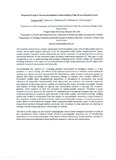
Antarctic Legacy Archive
Physical forcing of marine ecosystems in the vicinity of the Prince Edward Islands
- ALSA Home
- →
- Documents
- →
- Research: Events, Presentations, Posters
- →
- View Item
JavaScript is disabled for your browser. Some features of this site may not work without it.
| dc.contributor.author | Treasure, A.M. | |
| dc.contributor.author | Ruzicka, J.J. | |
| dc.contributor.author | Pakhomov, E.A. | |
| dc.contributor.author | Moloney, C.L. | |
| dc.contributor.author | Ansorge, I.J. | |
| dc.coverage.spatial | Southern Ocean | |
| dc.coverage.spatial | Prince Edward Islands | |
| dc.date.accessioned | 2021-03-10T14:47:06Z | |
| dc.date.available | 2021-03-10T14:47:06Z | |
| dc.date.created | 2016/07/27 | |
| dc.date.issued | 2016/07/27 | |
| dc.identifier.uri | http://hdl.handle.net/123456789/28671 | |
| dc.description.abstract | The Southern Ocean forms a major component within the global ocean and climate system and is a critical link in earth system processes [1,2]. Its ecosystems affect global biogeochemical cycles, sustain globally important marine biodiversity and will be important in maintaining food security by supporting fisheries [3], key resources under increasing international pressure [4]. The region is also recognised as key to understanding and perhaps mitigating global climate change [5]. Somewhat alarming therefore is the rapid rate of environmental change being experienced by the region with resultant impacts to ecosystems and food webs. Understanding the impacts of a changing physical environment on biological systems is a key question in marine ecology. The effects of the physical environment on Antarctic marine biological systems and species are well documented [6]. Nevertheless, while impacts of physical change on species have been recorded, linking ecosystem changes to physical ones remains difficult [7]. Ecosystem models allow computational exploration of disruptions on ecosystems that would otherwise be impossible experimentally. Such approaches are crucial in the Antarctic where the development of observing systems capable of explaining the causes of marine ecosystem changes and impacts of these changes on species and communities remains a challenge [7]. However, globally, much research to date has focussed on species-specific research. Therefore a great emphasis has been placed on the need for the development of modelling strategies that cut across traditional disciplinary clusters to span all levels of the biotic system, from end to end [8]. Building end-to-end models of ecosystems from the physics to top predators constitutes a way forward in this regard by creating a platform to better understand and predict changes in marine ecosystems under effects of environmental change. While integrated whole ecosystem views of the Southern Ocean from nutrients through primary producers and consumers to top predators are starting to emerge, models integrating physics and biology are lacking. Therefore, in this study, we use physical oceanographic data to drive biological ecosystem models of the sub-Antarctic Prince Edward Islands. Physical oceanographic processes are of considerable importance to the marine ecosystem in the vicinity of these islands [e.g. 9] and therefore changes to these processes are predicted to have significant impacts on species and communities. | en_ZA |
| dc.description.sponsorship | Sponsored by the the Department of Science and Innovation(DSI) through National Research Foundation (NRF) - South Africa | en_ZA |
| dc.description.statementofresponsibility | Antarctic Legacy of South Africa | en_ZA |
| dc.format | en_ZA | |
| dc.language | English | en_ZA |
| dc.publisher | South African National Antarctic Programme (SANAP) | en_ZA |
| dc.relation | SANAP Symposium 2016 | en_ZA |
| dc.rights | Copyright | en_ZA |
| dc.subject | Research | en_ZA |
| dc.subject | Science | en_ZA |
| dc.subject | Meetings | en_ZA |
| dc.subject | Symposium | en_ZA |
| dc.subject | SANAP Symposium 2016 | en_ZA |
| dc.subject | Southern Ocean | en_ZA |
| dc.subject | Prince Edward Islands | en_ZA |
| dc.subject | Marine Science | en_ZA |
| dc.subject | Living Systems | en_ZA |
| dc.subject | Ocean Science | en_ZA |
| dc.subject | Research | en_ZA |
| dc.subject | Physical Oceanography | en_ZA |
| dc.subject | Ecology | en_ZA |
| dc.subject | Ecosystems | en_ZA |
| dc.subject | Climate Change | en_ZA |
| dc.subject | Biological Ecosystems | en_ZA |
| dc.title | Physical forcing of marine ecosystems in the vicinity of the Prince Edward Islands | en_ZA |
| dc.type | Poster_Abstracts | en_ZA |
| dc.rights.holder | Antarctic Legacy of South Africa | en_ZA |
| dc.rights.holder | Treasure, A.M. | en_ZA |
| dc.rights.holder | Ruzicka, J.J. | en_ZA |
| dc.rights.holder | Pakhomov, E.A. | en_ZA |
| dc.rights.holder | Moloney, C.L. | en_ZA |
| dc.rights.holder | Ansorge, I.J. | en_ZA |
| iso19115.mdconstraints.uselimitation | This item and the content of this website are subject to copyright protection. Reproduction of the content, or any part of it, other than for research, academic or non-commercial use is prohibited without prior consent from the copyright holder. | en_ZA |
| iso19115.mddistributor.distributorcontact | South African National Antarctic Programme (SANAP) | en_ZA |
| iso19115.mdformat.name | en_ZA | |
| iso19115.mdidentification.deliverypoint | Antarctic Legacy of South Africa, Faculty of Science, Private Bag X1, Matieland. Stellenbosch. South Africa. | en_ZA |
| iso19115.mdidentification.electronicmailaddress | antarcticlegacy@sun.ac.za | en_ZA |
| iso19115.mdidentification.organizationname | University of Cape Town | en_ZA |
| iso19115.mdidentification.organizationname | Oregon State University | en_ZA |
| iso19115.mdidentification.organizationname | University of British Columbia | en_ZA |
Files in this item
This item appears in the following Collection(s)
-
Research: Events, Presentations, Posters [480]
Material directly related to official scientific and research events
